"offering a romantic tour through its political scandals, Broadway bars and downtown flophouses…" — Maureen Howard |
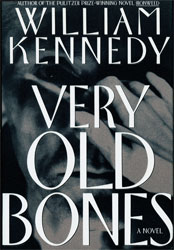 |
VERY OLD BONES (1982)
In the early spring of 1953, and with blinding illumination on through the fall of 1954, Peter Phelan came to perceive this: that individuals, families, or societies that willfully suppress their history will face a season of reckoning, one certain to arrive obliquely, in a dark place, and at a hostile hour, with consequences for the innocent as well as for the (conspirators). (Very Old Bones, p.189) –Very Old Bones
“The Phelans can claim a place beside O’Neill’s Tyrones and Steinbeck’s Joads as one of the premier families of American literature who endure and, one hopes, prevail. If you think great books are no longer being written, reading William Kennedy will change your mind.”(Library Journal, March 1, 1992)
"No character ever really dies in a Kennedy novel … For him, time is an expanding pool and not a straight line.”
— Noel O'Hara
|
In his review of Very Old Bones in The Recorder in 1992, the critic Noel O’Hara wrote, “We realize it is the commerce of Kennedy’s novels with the past and future that makes the Phelans profoundly different from the Karamazovs and the Compsons. There is no longing for a lost past of God-given opportunities, as there is with Faulkner, no sense of historic decadence whose state is the present of the Karamazovs, through whom Dostoyevsky probes the destiny of man in the light of his own Christianity … The meaning this novel distills from the whole cycle is that the past is darkness and the future is the possibility of light."
“Kennedy’s sweat and blood are evident in the perfected and purposeful difference of each novel from the others, even though all are, by and large, grounded in the same society and place. The straight 19th-century narrative style of Quinn’s Book was a surprise after the addictive free flow in space and time of Ironweed. In Very Old Bones, Kennedy has not only laid the old transatlantic ghosts, but we view Phelans in places other than Albany for much of the time. … No character ever really dies in a Kennedy novel … For him, time is an expanding pool and not a straight line.”
"Very Old Bones, is a grand leap, the very best of William Kennedy’s work so far.”
— Maureen Howard
|
Maureen Howard wrote in the New York Times Book Review, “What we have in Very Old Bones … is a masterly dig into the past of his own career by a writer who often seduces with the staged reality of his Albany, offering a romantic tour through its political scandals, Broadway bars and downtown flophouses, then leading us uphill to the really tough scenes behind the lace curtain sanctimony of Colonie Street. The Phelans, Daughertys, Quinns reappear in Mr. Kennedy’s novels at his direction, a hardy troupe that never grows stale as the resident company … Beneath the mete and just end of this closely worked novel lie bitter bones of estrangement, of love hidden or misplaced, lives wasted by jealousy and fear … this odd literary novel, Very Old Bones, is a grand leap, the very best of William Kennedy’s work so (far).” (New York Times Book Review, May 10, 1992)
Tom Adair wrote in his review in Scotland on Sunday that “Kennedy’s Albany-cycle [novels] … jostle Updike’s Rabbit Quartet for a claim on the pulse of modern America. Kennedy’s saga is generational, raiding the corners of a century that began in the 1850s, buck-riding the turbulence and the twitches of a stormy coming of age, if not coming to terms within the mesh of the family’s branches and stunted growth … There is an operatic grandiloquence in the emotions such scenes portray, a dandy flourish that matches the brio of Kennedy’s prose … This book is … a wonderful windfall for those who breathe their fiction neat. It proves that America is restless with self-discovery … gifting us with writers of genius. I have no doubt that this book is a classic; Kennedy’s best.”
". . . the novel has about it a crisp, authoritative ease—as though the truth were just hiding there on the outskirts of Albany. . ."
— Gail Caldwell
|
Author Alan Cheuse wrote, “Albany, N.Y., may not yet have taken its rightful place east of Winesburg, Ohio, and north of Yoknapatawpha County, Miss., on the great literary map that serious American readers keep in their minds. But it’s not for lack of trying on the part of novelist William Kennedy. He has produced several beautifully crafted and often quite moving novels in his so-called Albany cycle, the best known of these being Ironweed. Well, he’s still caught in that cycle, caught in the struggle and excitement and discoveries in the creation of it. With … Very Old Bones … the reader feels a certain cause for wonder as (well).” (Dallas Morning News, April 4, 1992)
Gail Caldwell wrote in the Boston Sunday Globe, “Posing as Orson’s memoir, Very Old Bones is an immensely gratifying novel, one that touches on the wildest and saddest parts of the Phelan clan. With its dialogue as chillingly perceptive as its family insights, the novel has about it a crisp, authoritative ease—as though the truth were just hiding there on the outskirts of Albany, waiting to be brought home … Kennedy has created such a mammothly persuasive group of people in this novel that it’s sometimes hard to tell who’s real and who isn’t … such is the power of seamless fiction … When Orson descends into the Phelans’ cellar, sent there by Molly on a devastating task, you can all but smell the musk and memories surrounding him. William Kennedy the realist may have sketched that scene, but it took a master of the human heart to deliver (it).” (Boston Sunday Globe, April 26, 1992)
Very Old Bones was published in Brazil, Denmark, France and Portugal.
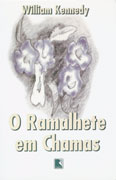 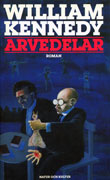
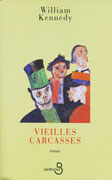 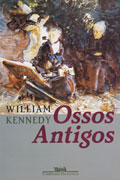
|
|